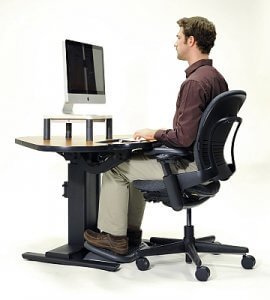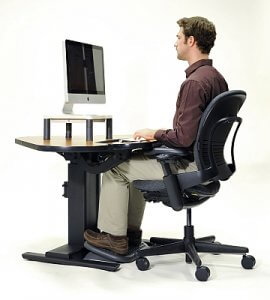How to Improve Your Posture During Seated Tasks
05/04/2020

Good posture is a predictor of good health. Like our physical and mental health, it is important to maintain good posture and become aware of our daily habits that enable poor posture. During these past few weeks, we have all been spending a large amount of time inside our homes, likely adopting a routine that is more sedentary than usual. With local gyms closed, working from home every day, and watching TV, sedentary behaviors are at an all-time high. With this new routine, how can we improve our posture? The first step is becoming aware of poor postures during our everyday seated tasks and acknowledging that improving posture requires time and attention.
Adjust Your Workstation
When working from home, it is important to adjust your workstation to fit your needs. A properly adjusted, seated workstation allows for good posture. Your office chair should be positioned to allow your feet to be flat on the floor with your knees at a minimum angle of 90 degrees. Your hips should be facing toward your monitor and your back should be as far back on the chair as possible. If your chair has back support, make sure you are using it. Your work desk should be tall enough that it is not touching your thighs but short enough that your arms can rest comfortably on it while your elbows are positioned at a 90-degree angle.
While you are seated in your desk chair, your monitor should be positioned at or slightly below eye height and approximately an  arm's length away. If you frequently make phone calls, consider using a headset or a computer program like Zoom to reduce the amount of time you are calling from your cell phone. If you use a laptop computer, it is recommended that you use an external mouse and keyboard.
arm's length away. If you frequently make phone calls, consider using a headset or a computer program like Zoom to reduce the amount of time you are calling from your cell phone. If you use a laptop computer, it is recommended that you use an external mouse and keyboard.
Using a mouse as opposed to your track pad allows your wrist and shoulder to remain in neutral postures throughout the workday. By attaching a keyboard, you can place your laptop screen where you need it and move your keyboard closer to the edge of the worktable to allow your arms to form a 90-degree angle while working.
Incorporate Standing Breaks During Prolonged Sedentary Activities
Take frequent standing breaks during seated tasks. During your workday, it is recommended that you stand or move for 10 minutes per hour. Some options include taking regular breaks, standing or walking during phone calls, or using a standing workstation. You can create a standing workstation anywhere in your home by keeping in mind the guidelines mentioned above for posture and monitor positioning. Being mindful of seated postures extends past your workday; while you are watching TV, make a habit of taking a standing or walking break in between episodes of your favorite Netflix shows.
With these tips, you can improve your posture and reduce your risk of developing a painful musculoskeletal disorder. Visit our Work-from-Home toolbox for more office ergonomics resources.






